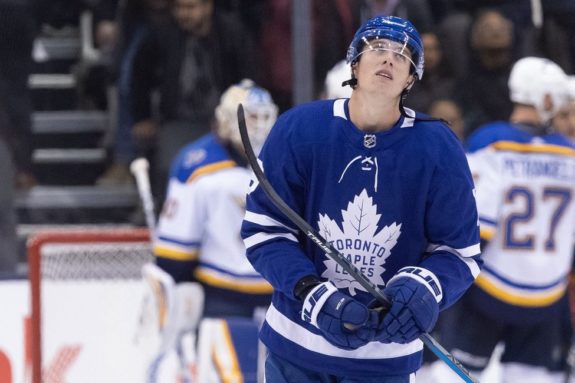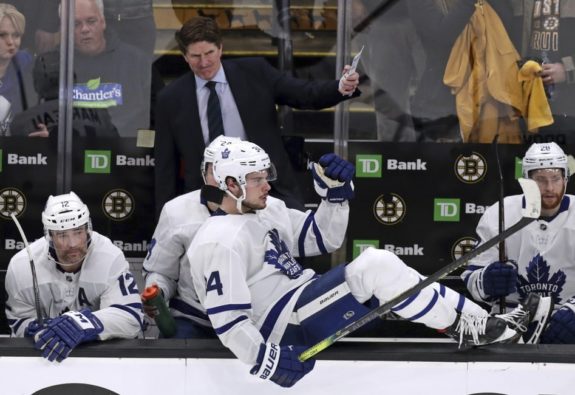Yesterday’s edition of Toronto Maple Leafs’ News & Rumors employed advanced hockey statistics to compare the regular season and playoff performances of Mitch Marner and Auston Matthews. The specific task was to address the thesis that Marner’s playoff performance was much poorer than his regular season performance, which was likely his most productive regular season ever.
Seeing With Our Eyes, and Supporting by Statistics
Obviously, as our readers pointed out, the playoffs are far different than the regular season – more intense, tighter checking, fewer obstruction penalties called. The elite players have less space to move. Other readers pointed out that they saw different things than the advanced statistics suggested. For example, they watched Marner over-handle the puck, play small, or remain on the perimeter. I saw similar things, and I also trust my eyes as much as the advanced statistics.

As a long-time academic researcher, I’ve come to accept that research doesn’t prove anything: it simply supports probabilities (as one reader wisely pointed out). However, good researchers (I believe) also employ a concept called triangulation, which simply means you gain as many insights as you can to answer your question. In that attitude, we owe any Maple Leafs’ player who’s trying a chance. Interestingly, not one reader said Marner or Matthews quit on the team – just that they were ineffective.
The Stanley Cup Finals Are a Time for a Seminar
Obviously, because all this happened right in front of our eyes, what we see and our common sense are important aspects of any decision-making. And now decisions must be made. In an earlier post, I noted that if I were the coaching staff I would make the Stanley Cup Finals a seminar where I would bring my coaches and players together to watch and break down the play just like I was having a university class.
Related: Maple Leafs’ News & Rumors: Matthews, Andersen, Muzzin & Tavares
If the Tampa Bay Lightning win, you can watch how they beat the neutral zone trap the Canadiens employ. If the Canadiens’ defense works again, they can diagram, conjecture, and theorize together about what to beat it. They can watch the system and the players. It’s a chance to take the next step towards success for the 23-year-old Matthews and the 24-year-old Marner.
Agree or Not, Marner and Matthews Are Young and Will Get Better
I honestly appreciate what readers and fans say in the comments’ section of my posts. Even if it’s venting, I get it. But one thing I won’t agree with is the belief that these two young multi-talented young forwards are as good as they’ll ever get. They’ll grow more savvy and more skilled; they’ll experience different contexts and situations. They’ll learn.

In my mind, Marner’s an elite hockey player. He’s 24 and he’ll get smarter and more able to apply his skills. My question is whether he’s driven enough and has the will to pull it all together. Matthews is something very special as a player – very special – in skill and drive. I have no question he’s driven. Now what?
What’s Sheldon Keefe to Do?
In this edition of Maple Leafs’ News & Rumors, I once again collaborate with Stan Smith to try to answer the question of how head coach Sheldon Keefe might get more out of both Marner (and Matthews, too) moving forward. It would be a fool’s bet that either young player is going anywhere during the lives of their contracts. One can never know for certain; however, despite vocal pleading from some Maple Leafs’ fans, we don’t think Marner is going anywhere soon. He’ll for sure be a Maple Leafs’ player at the start of next season.
Related: Maple Leafs’ Forgotten Ones: Jeff Finger
If that’s so, the question is, “How can Keefe get more out of Marner?” Here are our thoughts.
Thought One: Play Marner Fewer Minutes
As a coach, Keefe talks about how he managed Nylander’s minutes this season and how those managed minutes benefited both the young Swede and the Maple Leafs as a team. Marner, on the other hand, averaged 22:26 TOI during the regular season this year. That was second on the team to defenseman Morgan Rielly.
Not only is it more minutes than every other player on the team; in addition, it’s more than any defenseman on the team not named Rielly. That includes T.J. Brodie and Jake Muzzin. It was almost six more minutes a game than Nylander.

Then, in the playoffs, Keefe cranked up Marner’s time even further. He averaged 24:43. Although that included 30:22 in the longer overtime game, it wasn’t out of line with other games Marner played. Moving from Game 1 through Game 7, he logged 27:23, 22:50, 24:25, 19:41, 24:28, 30;22, and 23:55 against the Canadiens.
Our eyeballs suggest that both Marner and Matthews were completely gassed in the seventh game. [Matthews also averaged 21:33 as well.] That seems too much time invested in these elite players and less time used to develop the other lines, including the bottom six. Had those lines been more effective, the Maple Leafs might still be playing.
Thought Two: Take Marner Off the Penalty Kill
Obviously, Marner’s on the penalty kill because he’s good at it. In fact, he’s a tenacious penalty killer. He has a great combination of hand/eye coordination; he’s able to read the play; and, his speed and transition game makes opposing teams wary of giving up scoring chances.
Related: Beauts Free Agent Camp Filled with Optimism, Familiar Faces
Again using naturalstattrick’s advanced statistics, when Marner’s on the ice in a penalty killing role, the Maple Leafs generate 13 High Danger Scoring Chances to the opposition’s 21 High Danger Scoring Chances. That means the Maple Leafs generate about 60% as many the scoring chances as the team with the extra attacker. No wonder Keefe likes him in that role.
That said, of Marner’s 22:26 TOI during the regular season, 2:04 of that was spent killing penalties. That’s two minutes of intense, all out skating, which must be exhausting. Removing that element from his game drops his TOI to about 20 minutes each game, which is more ideal for a first-line player. In addition, the Maple Leafs have several players who could become effective penalty killers, such as Alex Kerfoot, Ilya Mikheyev, and Pierre Engvall.
Thought Three: Take a Lesson from Mike Babcock
I admit that I appreciate Keefe more than I did Mike Babcock as a head coach, and I read that the team did as well. Still, Babcock had some success, and he simply refused to play Marner and Matthews together. On the other hand, Keefe refuses to take them apart. Maybe a mix of both is needed.

Using the example of other teams with two great players, when the Chicago Blackhawks were a powerhouse, Patrick Kane and Jonathan Toews played together sometimes and played apart sometimes. The Edmonton Oilers sometimes play Connor McDavid and Leon Draisaitl together sometimes and apart sometimes.
Such deployment shakes things up without allowing the opposition to key on one line. One issue that the Maple Leafs had during the playoffs that’s been mentioned but not always given much credence is that John Tavares was out with an injury. Nylander did well, but Tavares might have been more of a key loss to the team than people imagine.
Speaking of Tavares, Keefe put him with Marner during the regular season and that jumped Tavares’ production. So, unless it’s absolutely necessary, separating Matthews and Marner could benefit the team’s ability to develop other effective lines. It couldn’t hurt to have Marner spend more time with Tavares or Matthews spend more time with Nylander. It’s worked in the past.
What’s Next for the Maple Leafs?
The point of our post is that Marner’s an elite player, who’s also one of the best playmakers in the NHL. His on-ice vision is second to none. He has a high hockey IQ.
Related: Was There a Chance Sidney Crosby Could Have Played in Toronto?
But the plain truth is that, advanced statistics or not, he didn’t produce as much as he could have. How do the Maple Leafs help him take that next step? How can the team help him become productive both in the regular season and during the high-pressure of the playoffs.
Helping Mitch Marner succeed in those situations is the next step towards the Maple Leafs’ success as we see it.